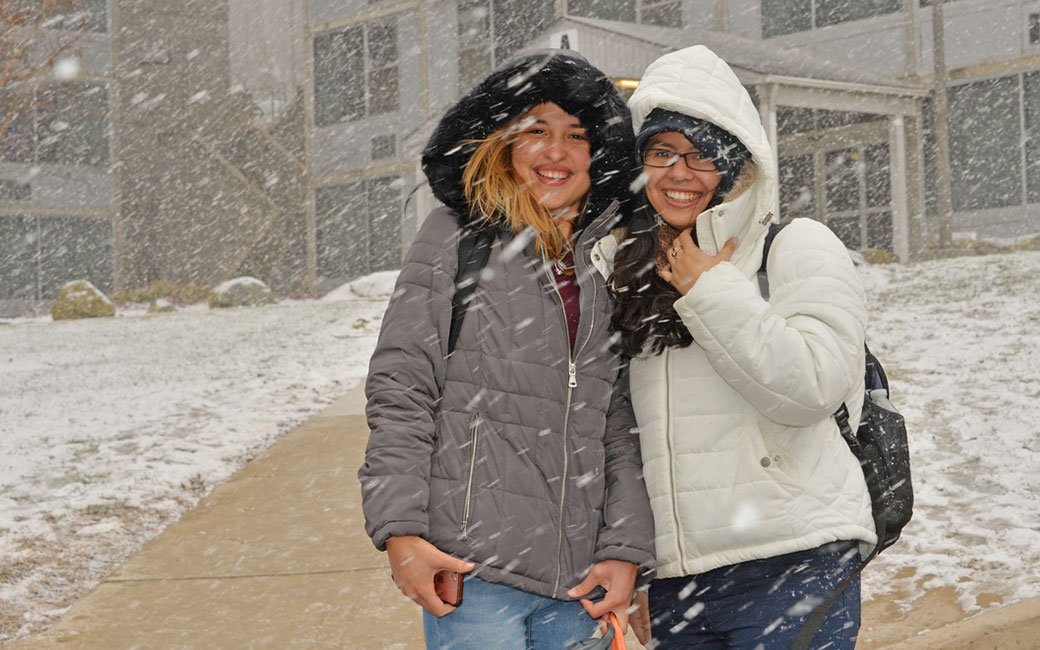From 6 degrees to 60? TU experts weigh in on extreme weather
Towson University professors explain the cause of extreme temperature swings and the effects on ecosystems, the economy and more
By Megan Bradshaw and Rebecca Kirkman on February 3, 2019

From last week's single-digit temperatures to spring-like highs expected this week, the Towson area has been hit by extreme temperature swings in the past week. What’s behind the crazy weather, and what does it mean for infrastructure, ecosystems, and the economy?
We turned to campus experts in biological sciences, nursing, economics, and geography and environmental planning to explain the cause and potential impact of recent weather events.
What is a polar vortex, and how is it impacting the low temperatures we’ve been experiencing?
There are actually two polar vortices. One is in the lowest level of the atmosphere, known as the troposphere (think of the jet stream), and the other is the next, higher level, known as the stratosphere (where the ozone layer is located).
These vortices help separate cold arctic air from warmer air at lower latitudes. When the vortices are strong (meaning the wind is moving west to east really fast), they are pretty effective at keeping the really cold air confined to the polar region. When the vortices weaken, they begin to meander in waves, and allow warm air from lower latitudes to migrate into polar regions and cold air from the polar regions to migrate into lower latitudes.
The polar vortices in the Northern Hemisphere have recently been in meandering, wavy configurations. This has allowed extremely cold Arctic air to move southward into the eastern half of the United States. Another region of extremely cold air also moved southward into Siberia.
What can cause temperatures to change by 50 degrees in a few days?
Large waves in the polar vortex not only allow cold air to migrate toward lower latitudes, they also allow warm air from lower latitudes to migrate toward the poles. These waves move from west to east around the planet. While a location is under the trough (a dip in the jet stream toward the equator) of one of these waves, temperature will be anomalously cold. Eventually, the wave will move eastward and the location will be under the ridge (or crest), and the temperature will be anomalously warm.
The eastern United States has recently been under a trough where cold air has been surging southward, which is why temperatures have been so frigid. By late this weekend and early next week, the trough will recede northward and eastward. This will allow warm air from the south to surge northward. In Towson, we are set to have spring-like temperatures (approaching 60°F) by mid-week.
How do swings in temperature impact infrastructure?
Materials expand and contract as the temperature changes and these changes in volume can lead to damage. For example, water expands as it freezes and contracts as it melts.
While temperature is above freezing, liquid water can seep into cracks in the road or even the foundation of a house. This water will expand as it freezes when the temperature drops below freezing. This expansion can damage roads and house foundations. The expansion of water as pipes freeze also wreaks havoc in extreme cold temperatures.
Have severe temperature changes always occurred, or is this becoming increasingly common?
Extreme temperature changes are rare, but they have always been a part of Earth’s climate (as far back as records and proxies go). There is some evidence that the polar vortices have weakened and assumed wavier patterns more often in recent decades, and these waves have been accompanied by extreme temperature swings.
It is possible that temperature will become more volatile (particularly in winter when the polar vortices are strongest and most apparent) if these waves continue to increase in frequency.
In general, how do extreme temperatures affect vulnerable populations?
Homelessness limits access to basic survival necessities (food, water, shelter, clothing), while mental illness can add more complexity by causing impaired judgment and self-neglect. There is strong stigma associated with both populations, so they are often feared or overlooked by the general public.
They may also avoid seeking help because of negative experiences they have had in the past. For example, theft and violence can occur in shelters and make them very unpleasant places to be. Shelters also quickly become overcrowded and have to turn folks away.
Because these folks often do not have reliable access to shelter, they are at greater risk for things like hypothermia or heat stroke when temperatures approach extremes. They also have reduced access to quality health care options, so small medical problems can turn into severe medical problems very quickly, particularly when individuals lack basic resources to stay healthy, like food and clean water.
What are the effects of rapid temperature change like we'll be experiencing on those individuals?
Often these individuals carry all of their possessions with them, so it becomes difficult to carry everything you would need for both extreme cold and warm weather. In general, folks are more likely to help homeless and mentally ill individuals when conditions are extreme, but their needs do not go away just because the weather improves.
Are there any ways to help them mitigate those effects?
Yes! Folks can call 311 or 211 in most cities nationwide if they are concerned about someone they see on the street and activate a homeless outreach response or find out about local resources.
Of course, you should call 911 for true medical emergencies if you suspect someone is in severe distress. Knowing your local emergency shelters, free health clinics, and soup kitchens so that you can refer folks in need is extremely helpful. In Baltimore, try Paul’s Place Outreach, Healthcare for the Homeless, various churches, etc.
You can donate essential items to shelters or keep them in your car to hand out to folks on the street. For a long-term impact, monetary donations to respected organizations that serve homeless and mentally ill populations are much needed, or you can get involved with policy and legislation change in your area to improve care for vulnerable populations, like the mentally ill and homeless.
How do temperatures affect the ecosystem and organisms living in it?
Generally, as temperatures warm, physical, chemical and biological processes basically speed up. In temperate climates like the mid-Atlantic experiences, we can clearly see this as we transition among the seasons. Importantly, the temperature changes that drive these seasonal processes are pretty gradual, occurring over the time period of weeks to months.
How does extreme temperature variation affect ecosystems?
Large temperature fluctuations can have very significant impacts on organisms and ecosystems. This question is a major and active research area being addressed by scientists across the globe. Also, when we see temperature extremes in Towson, it is important to consider that these local changes are indicative of fairly large-scale climate phenomena. So, the effects to organisms and ecosystems are hard to clearly identify and can be dramatic depending on the scale that we consider.
It is, however, often easier to think of these effects at a more local scale. In laboratory studies, we’ve seen that temperature fluctuations, even within “normal ranges” for some organisms, can make them more sensitive to other stress factors. In a paper we are submitting for publication next week, my master’s student, Frank Green, has shown that locally collected green frogs are more sensitive to road salt at slightly higher temperatures. Considering the amount of salt deposited on roads, it seems likely that over-wintering amphibians (like green frogs) may be even more sensitive to salt stress with even short pulses of higher temperatures.
In other years, I’ve also observed some plants beginning to bloom far ahead of schedule because of likely climate triggers. The magnitude and occurrence of any particular effect will depend on the magnitude and likely duration of the temperature extremes.
If these extreme variations become more frequent, how will that affect organisms and their abilities to adjust?
Organisms and ecosystems are pretty resilient to occasional perturbations, but repeated perturbations are much more difficult for organisms and ecosystems to rebound from. So over longer timescales, we could very likely see a decline in biodiversity and a decrease in the services we depend on from ecosystems.
Extreme climate perturbations (including extreme precipitation) can challenge many organisms, likely leading to loss of species or, at least, a diminishment in numbers.
How could this affect humans?
This is a great question. Humans obtain many benefits from ecosystems, including food, recreation, aesthetics, protection (from floods and temperature, for example), medicine and building materials, and the list goes on. Hence, if we expect to see large changes in ecological systems associated with climate variability, we are very likely to see decreases in the ecosystem services on which we depend.
An example that’s perhaps easy to visualize is a core cultural value in Maryland: seafood. The record precipitation in 2018 and large temperature extremes may translate to impacts to the already-stressed Chesapeake Bay and the organisms like crabs and oysters that are economically and culturally important to us. But the potential effects can be varied and unexpected… because this is a new climate reality.
How do extreme temperatures affect vulnerable populations like individuals with asthma or chronic illness?
When kids are diagnosed with asthma, their bronchial tubes known as their airways become inflamed followed by swelling. Certain triggers can lead to a child having an asthma attack. Both cold temperatures and sudden weather changes are triggers for kids with asthma.
What are the effects of rapid temperature change on those individuals?
The past few days and the upcoming days can be extremely dangerous for a child diagnosed with asthma in Maryland. The temperature going from 10 to 60 degrees Fahrenheit within a week can cause a severe asthma attack. A severe asthma attack can cause the child to be admitted to the hospital and placed in the Pediatric Intensive Care Unit (PICU) on a ventilator.
To prevent the child from having an asthma attack, outdoor activities must be limited during this time. If the child must be outside, a scarf should be worn over the child’s mouth and nose. Due to the extreme changes in the weather temperature, the child should always have a rescue or fast-acting medicine (also known as quick-relief) on hand.
What are some of the areas of the economy that take a hit when extreme weather happens?
Largely speaking, the areas are the ones you would expect—infrastructure, airline traffic and retail are the bigger ones. With the polar vortex that is happening now, the airlines took an economic hit with cancellations, delays and consumer frustration.
Does consumer spending really decrease during extreme weather? Wouldn't online retail cover the loss of foot traffic in stores?
From a retail perspective, online shopping does make up a good deal for loss of foot traffic in stores. But the industries that lose out are the ones that can’t really be replaced by online retail. With extreme cold, people don’t go to the movies or out to dinner, so consumer spending does decrease in those areas.
Would the economic impacts of extreme weather affect areas of the U.S. that are not experiencing the weather events? Or would they be localized?
Here is where the trouble the airlines experience has double the impact. Not only can people not get out of the areas experiencing bad weather, but tourism and consumer spending in the places of the country or world where they were going takes a hit. Additionally, businesses are affected by lower productivity and potential supply chain delays. But unless the weather is extreme for a long time, the delays would be short lived.
